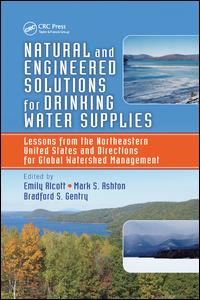Gray to Green: An Introduction to Four Case Studies on Drinking Water Supply in the Northeastern United States; Caitlin Alcott, Emily Alcott, Mark S. Ashton, and Bradford S. GentryExecutive Summary Introduction: Defining the Issue National Trends The Northeastern United States Description of the Case Studies An Assessment of Drinking Water Systems in Connecticut: Optimizing Natural and Engineered Systems for Protecting the Quality of Surface Drinking Waters; Michael Blazewicz, Lisa Hummon, Claire Jahns, and Tien ShiaoExecutive Summary Introduction History and Current Status of Drinking Water Supply Systems in Connecticut The South Central Connecticut Regional Water Authority The History of Aquarion Water Company of Connecticut Current Legal Efforts to Address Water Supply Challenges in Connecticut Current Land Management Efforts to Address Water Supply Challenges in ConnecticutFuture ChallengesRecommendationsSource Water Protection in Massachusetts: Lessons from and Opportunities for Worcester and Boston; Emily Alcott, Peter Caligiuri, Jennifer Hoyle, and Nathan KarresHistory and Current Status of Drinking Water Supply in Massachusetts Statewide Challenges: Trends Facing Water Utilities Land Use Policy, Monitoring, and Asset ManagementComprehensive Approach to Drinking Water Supply ManagementSummary Trends, Recommendations, and ConclusionsNew York City Watershed Management: Past, Present, and Future; Justin Freiberg, Xiaoting Hou, Jason Nerenberg, Fauna Samuel, and Erin DerringtonHistory of New York City Watershed Current Profile of the New York City Watershed Future Threats and Suggested Actions Future Decision-Making OutlookSummary Trends and RecommendationsThe Crooked River Watershed, Sebago Lake, and the Drinking Water Supply for the City of Portland, Maine; Jenn HoyleWater Supply Protection and the Portland Water District Watershed Control Program of the Portland Water District Water Supply Trends and the Value of Watershed Protection Development Pressures on Watershed Lands Potential Payments for Watershed Services Programs for the Portland Water DistrictSummary Recommendations and ConclusionsComparing Drinking Water Systems in the New England/New York Region: Lessons Learned and Recommendations for the Future; Caitlin Alcott, Emily Alcott, Mark S. Ashton, and Bradford S. Gentry Executive Summary Introduction Surface Watersheds of New England and New York: Green and Gray Infrastructure Cross-Cutting Themes for the Drinking Water Utilities Recommendations Future Research and ConclusionsGlobal Relevance of Lessons Learned in Watershed Management and Drinking Water Treatment from the Northeastern United States; Alex Barrett and Mark S. AshtonMethods Biophysical Considerations and Constraints Forest History, Land Use, and Infrastructure Development Human Institutions: Legal, Social, Governmental and Regulatory Global Applications of the Lessons Learned Quabbin and Dahuofang Reservoirs: Example of a Comparative Analysis Index











